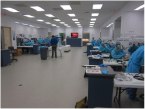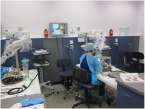Report on Musha-shugyo: Yoshiro Ito
Course: Advanced Skull Base Microanatomy & Hands-on Dissection Workshop
Period: September 17-20,2011
Venue: Palm Beach Gardens, FL, USA
Research Institution:International Neurosurgery Education & Research Foundation
Foundation:Takanori Fukushima
Report on Participation in Anspach Skull Base Workshop
1)Objectives
Today, due to the progress of radiation therapy and neuroendovascular therapy, we have fewer chances to experience surgeries on patients who are in need of complicated neurosurgical treatment such as scull base surgery. As a part of a surgical training, there are training courses where they use the head of donated cadaver but it is rare in numbers in Japan today and is also getting difficult to participate in. Thus, I have decided to participate in this workshop to learn the surgical dissection of skull base surgery.
2)Outline of Workshop
The workshop was held at a laboratory within the Synthes Anpach at Palm Beach Gardens, Florida, USA. This workshop began in 1995 and is presently held three times a year. There were 30 participants in this workshop, 3 of them special lecturers. During the day, both in the morning and in the afternoon, after a short lecture using textbook, we learned the surgical dissection using the head of cadaver. We were given the head for every 2 participants. The equipments we used were almost exactly the same as the ones we use in the actual surgery. And just as in the actual surgery, we started from skin incision and learned the surgical approach of the surroundings of skull base. At night, the participants stayed at the nearby hotels.
3)Head of Donated Cadaver
We used a head cut off from the donated cadaver. In the U.S., they have businesses where they provide a cadaver for surgical dissection training. The cadaver was soaked in a particular mixed solution of alcohol and formalin and red dye was injected into artery and blue dye into vein.
4)Observation
Until now, I have participated in similar workshops in Japan and there have been workshops in the University of Tsukuba for relative parties in school to participate (not held this year). In Japan, because we use the head fixed in formalin, the brain tissue is hard and it is difficult to identify the arteriovenous of the blood vessels. But the cadaver we used in this workshop was different compared to those used in Japan where the brain was soft, almost like the actual brain tissue and the blood vessels were identifiable which gave me the actual feeling of performing the surgery. And because we were given a cadaver for every 2 participants (in Japan, a cadaver for 3-6 participants), I had enough time to perform the training. The cost-effectiveness is thought to be high compared with workshops in Japan, which costs about 100,000 yen for 2-day training where this 3-day workshop cost 1,800 USD with the textbooks included (550 USD for textbook) .
The dissection practices are conducted in school but it is nothing like the actual surgical dissection. There are also many textbooks published on them but it is difficult for one to understand them in three dimensions. By conducting the surgical dissection, new questions came up and I keenly sensed the need for sequential trainings.
I was also motivated by the participating surgeons who were ardent and didn't hesitate to pay money for their expenses.
Unfortunately, in Japan, there hasn't been enough maintenance of trainings for surgical dissection. In the future, I hope the workshops with same quality would be held in Japan.
(From Musha-shugyo Report)
 Musha-shugyo Photos
Musha-shugyo Photos
* Click on thumbnails.


